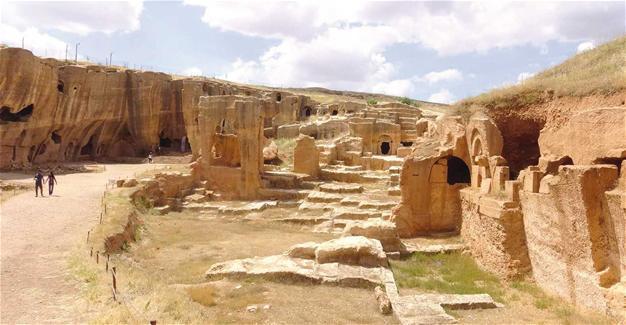Mardin’s gallery grave opens to visitors
MARDİN – DHA

A 1,400 year-old gallery grave unearthed during archaeological works in the ancient city of Dara in the southeastern province of Mardin has been opened to visitors after necessary measures.
Located in the Dara neighborhood, 30 kilometers from Mardin, the ancient city of Dara was one of the most important settlements of Mesopotamia. The gallery grave, unearthed seven years ago, was a place for “resurrection” ceremonies in the Roman era.
Excavations in Dara revealed that the field of the grave served various cultures and faiths for centuries. In 2010, hundreds of human bodies were found in the lower layer of the grave. It is believed that they wanted to be buried in the graveyard to come to life again one day.
The area, which was established in the 6th century by the Romans for resurrection ceremonies, is believed to be one of a kind and the only one in the world, which is why findings in the grave have been protected in their original place.
With a funding of 85,000 Turkish Liras by the Dicle Development Agency (DİKA), the gallery grave was restored, its entrance was covered with glass and a walking platform was established for visitors. With the completion of all the works in the grave, it is now open to visitors.
Candles for souls to reach heavenMardin Governor Mustafa Yaman, Kocaeli Metropolitan Mayor İbrahim Karaosmanoğlu and many other guests have recently attended an opening ceremony for the grave.
“This grave was used in the 6th and 7th centuries. It is home to the bones of people who believed they would resurge one day. We unearthed the bones during excavations. The grave was built by eastern Romans in 591 AD in memory of those who were killed by the Sasanians in the 573 AD war. Archaeological excavations carried out by the Mardin Museum unearthed hundreds of human bones in 2010 as well as candles and water bowls. Candles were believed to play role in the transition to heaven; therefore there was a candle in each grave,” Culture and Tourism Provincial Director Alaaddin Aydın said.
Aydın said the ancient city of Dara was formed in 507 AD by the Romans to be used as a military headquarters.
He said authorities have carried out works in the field since 2010 for the restoration and environmental arrangement of the Roman graveyard.
Aydın said the 1,400-year-old cemetery could serve for tourism in the region, adding that the measures taken enabled the ancient city to become more accessible to tourists.
He added that visitors who wish to envision what the Roman era was like can see traces of ceremonies by touring the city.
Bones of 3,000 peopleAydın said the gallery grave carried the bones of 3,000 people who are waiting to resurge.
“The big gallery is made up of three layers created by carving the limestone main rock. The layers have different functions. The upper layer is the area for ritual scenes, the center layer is the place for individual burials, and the lower layer is the place for multiple burials. The entrance to the big gallery is possible through a magnificent door with reliefs on it. The reliefs depict resurrection scenes. There is a winged figure on the left side of the relief. In the left bottom of this figure is a mass of bones and human skulls which are symbolizing the dead. There is also a winged angel relief. On the right bottom of this angel figure there is another relief, which is believed to symbolize the hand of god. On the right side of the door, there are the figures of the Virgin holding his son in her hands. Above this scene there is a roof relief symbolizing the church,” he added.
 A 1,400 year-old gallery grave unearthed during archaeological works in the ancient city of Dara in the southeastern province of Mardin has been opened to visitors after necessary measures.
A 1,400 year-old gallery grave unearthed during archaeological works in the ancient city of Dara in the southeastern province of Mardin has been opened to visitors after necessary measures.